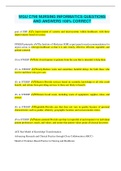WGU C790 NURSING INFORMA TICS QUESTIONS AND ANSWERS 100% COR RECT goal of EBP ✔✔is improvement of systems and microsystems within healthcare, with these improvements based on science STEEEP principles ✔✔The Institute of Medicine (IOM) expert panel issued recommendations for urgent action to redesign healthcare so that it is safe, timely, effective, efficient, equitable, and patient -centered (S) in STEEEP ✔✔Safe-Avoid injuries to patie nts from the care that is intended to help them . (T) in STEEEP ✔✔Timely -Reduce waits and sometimes harmful delays for both those who receive and those who give care. (E) in STEEEP ✔✔Effective -Provide services based on scientific knowledge to all who coul d benefit, and refrain from providing services to those not likely to benefit. (E) in STEEEP ✔✔Efficient -Avoid waste, including waste of equipment, supplies, ideas, and energy. (E) in STEEEP ✔✔Equitable -Provide care that does not vary in quality because of personal characteristics such as gender, ethnicity, geographic location, and socioeconomic status. (P) in STEEEP ✔✔Patient -centered Provide care that is respectful of and responsive to individual patient preferences, needs, and values, and ensure that patient values guide all clinical decisions. ACE Star Model of Knowledge Transformation Advancing Research and Clinical Practice through Close Collaboration (ARCC) Model of Evidence -Based Practice in Nursing and Healthcare Johns Hopkins Nursing Evidence -Based Practice Model and Guidelines Iowa Model of Evidence -Based Practice Stetler Model of Research Utilization ✔✔FOCUS: EBP, research use, and knowledge transformation processes DESCRIPTION: Direct a systematic approach to synthesizing knowledge and tran sforming research findings to improve patient outcomes and the quality of care Address both individual practitioners and healthcare organizations Focus on increasing the meaningfulness and utility of research findings in clinical decision making Promotin g Action on Research Implementation in Health Services (PARiHS) Vratny and Shriver Model for Evidence -Based Practice Pettigrew and Whipp Model of Strategic Change Outcomes -Focused Knowledge Translation Determinants of Effective Implementation of Complex In novations in Organizations Ottawa Model of Research Use ✔✔FOCUS: Strategic and organizational change theory to promote uptake and adoption of new knowledge DESCRIPTION:Trace mechanisms by which individual, small group, and organizational contexts affect diffusion, uptake, and adoption of new knowledge and innovation Premise is that interventions, outcomes evaluations, and feedback are important methods to promote practice change Collaborative Model for Knowledge Translation between Research and Practice Settings Framework for Translating Evidence into Action Knowledge Transfer and Exchange Canadian Institutes of Health Research Knowledge Translation within t he Research Cycle Model or Knowledge Action Model Interactive Systems Framework for Dissemination and Implementation ✔✔FOCUS: Knowledge exchange and synthesis for application and inquiry DESCRIPTION: Structure ongoing interactions among practitioners, res earchers, policy -makers, and consumers to facilitate the generation of clinically relevant knowledge and the application of knowledge in practice All parties are engaged in bidirectional collaboration across the translation continuum Knowledge Transforma tion ✔✔(Ace Star Model) is defined as the conversion of research findings from discovery of primary research results, through a series of stages and forms, to increase the relevance, accessibility, and utility of evidence at the point of care to improve h ealthcare and health outcomes by way of evidence -based care . Ace Star Model ✔✔These five points are discovery research, evidence summary, translation to guidelines, practice integration, and evaluation of process and outcome clinical practice guidelines (CPGs) ✔✔The IOM defines clinical guidelines as "systematically developed statements to assist practitioner and patient decisions about appropriate health care for specific clinical circumstances. usability ✔✔1.Increased user productivity and efficiency 2 .Decreased user errors and increased safety 3.Improved cognitive support human factors ✔✔is "the scientific discipline concerned with the understanding of interactions among humans and other elements of a system, and the profession that applies theory, pr inciples, data and methods to design in order to optimize human well -being and overall system performance." In healthcare, human factors might concern the design of a new operating room to better support teamwork and patient flow. ergonomics ✔✔used inter changeably with human factors by the HFES in Europe but in the U.S. and other countries its focus is on human performance with physical characteristics of tools, systems, and machines i.e. power drill fitting in hand Human -computer interaction (HCI) ✔✔is the study of how people design, implement, and evaluate interactive computer systems in the context of users' tasks and work usability ✔✔is often used interchangeably with HCI when the product is a computer but usabil ity also concerns products beyond computers. Usability is also more focused on interactions within a specific context or environment for a specific product . Formally, the ISO defines usability as the extent to which a product can be used by specific user s in a specific context to achieve specific goals with effectiveness, efficiency, and satisfaction. allows users to achieve goals joint cognitive systems ✔✔imply that information is shared or distributed among humans and technology. This framework is use ful for examining teamwork in healthcare where team members work together on patient care Health Human -Computer Interaction (HHCI) Framework ✔✔Humans or products can initiate interactions. The information is processed through either the product or the hum ans according to characteristics. The recipient then reacts to the information; for example, a healthcare provider could read and respond to email from a patient or a product might process interactions after the "enter" key is pressed. Iterative cycles con tinue as humans behave and products act according to defined characteristics. Goals and planning are implicit within the tasks displayed in the framework. discount usability methods ✔✔reduce the number of required users in usability projects and to use early design prototypes. These methods offer economies of time, effort, and cost and can be completed at any point in the systems life cycle. Two common techniques are heuristic evaluation and think -aloud protocol.




